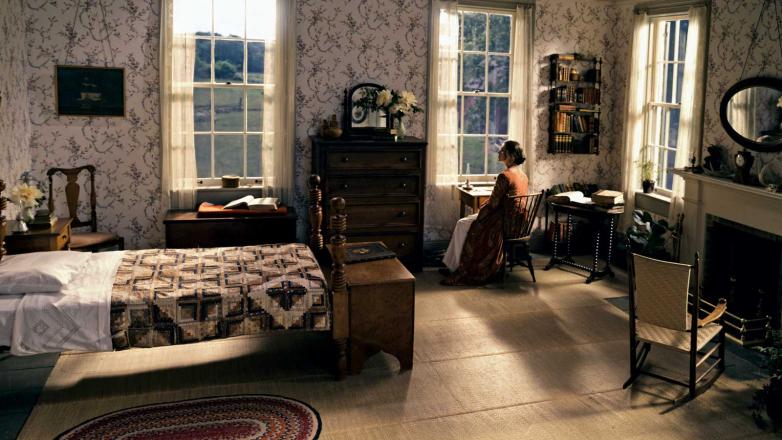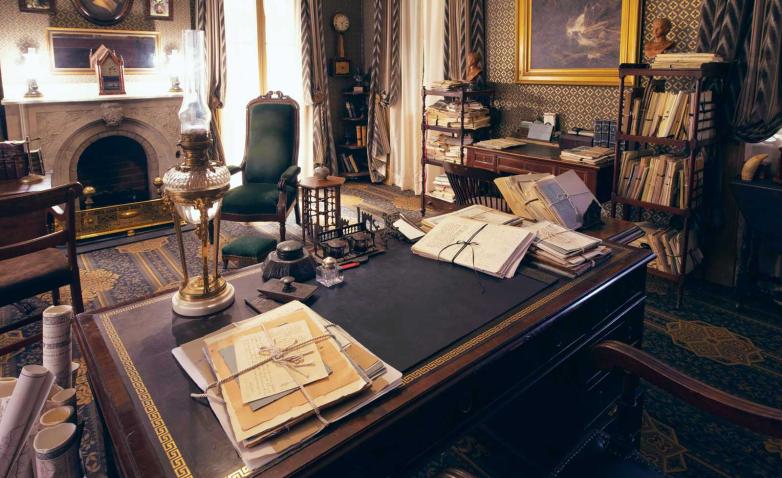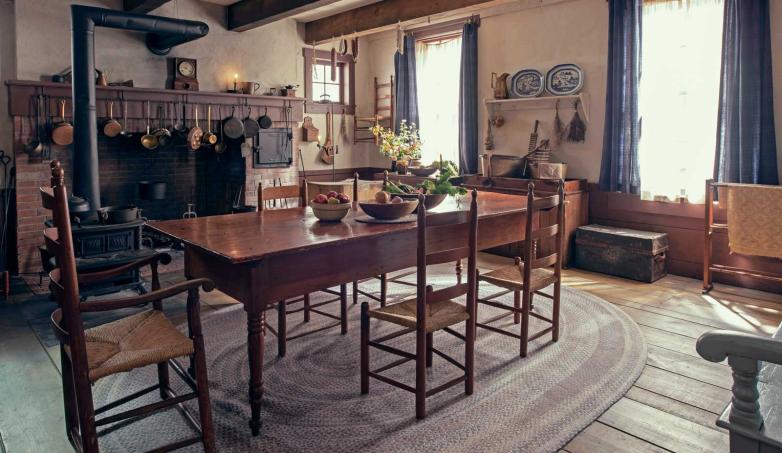Emily Dickinson, Drama Queen
Two institutions have acquired props and scripts from a popular literary TV series
The typical fate of a television set and its contents post-production is not pretty; cast and crew may select a memento or two, but the scrap heap is the usual destination. Not so for many of the set pieces and paper props from the beloved Apple TV+ series Dickinson (2019–2021). The Houghton Library at Harvard University in Cambridge, Massachusetts, and the Emily Dickinson Museum in Amherst, Massachusetts, have acquired many of the pieces that helped transport viewers back to the 1800s. The bulk of the paper materials—scripts, reproductions of poems, letters, and newspapers—went to Cambridge, while costumes and other props will be pressed into service in Amherst after the museum’s major renovation wraps up this summer.
The thirty-episode series takes mind-bending trips into Emily Dickinson’s imagination to find the creative well from which sprang forth such poems as “I’m Nobody! Who are you?” and “‘Hope’ is the thing with feathers.” While showcasing the poet and her place in history, the show’s creator Alena Smith said she saw “Emily Dickinson and her life and times as an avatar to explore… the experience of contemporary twenty-somethings coming of age today in this troubled American landscape.” By her own account, Smith’s “obsession” with perfecting the show’s tangible details grew out of her keen interest in the famously introverted writer. “I gave my life to this show for close to a decade.”
As such, research required consulting the Houghton Library’s 1,023-piece Dickinson archive, where Smith struck up a friendship with Christine Jacobson, assistant curator of modern books and manuscripts. When the series wrapped, as a thank-you, Smith asked if Jacobson would like anything from the set, leading to the Houghton acquiring numerous items, including exquisite reproductions of Dickinson’s delicate fascicles—those bundled poems Dickinson stitched together with needle and thread. (Each smudge and ink blot on the reproductions came courtesy of graphic designer Derrick Kardos, who worked on the film Black Swan and helped restore some of Frederick Douglass’s North Star newspapers for the Smithsonian.) Jacobson said the new acquisitions will likely serve as teaching aids. “The reproductions are a treasure. Students can handle them, and we don’t have to worry about them like the originals,” she said.
Smith was equally excited that the Dickinson Museum received “truly, millions of dollars’ worth of physical items from the show—carpets, curtains, dishes, an entire kitchen—which, otherwise would’ve been thrown in the dumpster.” That’s show business, but Smith was pleased to find a happier ending. “It’s so fleeting. You don’t usually get to hold on to that much once you’ve made the show,” she said.
Jane Wald, executive director of the Emily Dickinson Museum, praised the acquisition. “We have a good deal of Dickinson family furnishings but not everything we need. We selected pieces that would help fill our needs.” Fans of Dickinson who trek to the museum after it reopens will no doubt relish recognizing pieces from the show, including Death’s carriage.
Though Emily Dickinson has been a cultural touchstone for academics and afficionados alike, it seems the current fascination can be traced to 2017, when a retrospective at the Morgan Library & Museum in New York sought to reassess the life and works of a poet once branded “the Myth” and “the Belle of Amherst;” a recluse who never left home, who whispered to visitors through doorways, and whose sole companion was a faithful Newfoundland named Carlo. Dickinson led a far more nuanced life than she was given credit for, and Dickinson is the latest contemporary reassessment.
Jacobson sees the acquisition as indicative of the enduring power of the poet and her work. “This is part of Emily’s story,” she said. “Scholars who want to examine her legacy, her role in literature, and in popular culture can look at Alena’s Dickinson as part of that canon.” Smith agreed. “Dickinson can become fetishized for those obsessed with her—including me—the idea that such wild creativity could have sprung from such limits is so astounding.”
For Dickinson’s lead decorator, Marina Parker, who left no stone unturned when sourcing, acquiring, and fabricating the set, drawing attention to craftspeople who are still making things the ‘old-fashioned’ way is also important. “It is incredibly gratifying that the effort we put into the details is being recognized and that so much of the set dressing, including nineteenth-century furniture, is being folded into the Emily Dickinson Museum to furnish her house,” Parker said. The show’s punch list was exhaustive: “Carpets woven by punch cards on jacquard looms. Yarn dyed. Wallpaper block printed. Glass hand blown.” Curators at various museums pointed her in the direction of artisans who use nineteenth-century techniques. For example, “Family Heirloom Weavers in Red Lion, Pennsylvania, have been weaving for generations,” Parker said. “Their yarn was dyed by a company done in by Covid.” Other vendors included Adelphi Paper Hangings in Sharon Springs, New York; Amherst’s own Cooper Lace; Antique Stove Hospital in Little Compton, Rhode Island; and David Rose Antiques in Upton, Massachusetts.
The preservation of contemporary artisans’ products testifies to a tradition of craftsmanship still flickering across America. Among the pieces sent to the Houghton was a scrapbook Parker created to document these vendors. “I’ve never done that before,” she recalled. A serendipitously fitting coda to the enduring legacy of the show’s subject is how these objects will remain relevant after the show’s finale. “One of the least satisfying aspects [of working on TV shows] is how temporary it all is. It all goes away instantly. There’s no permanence. It’s so gratifying to have some of our work live on in a more permanent way.”


















